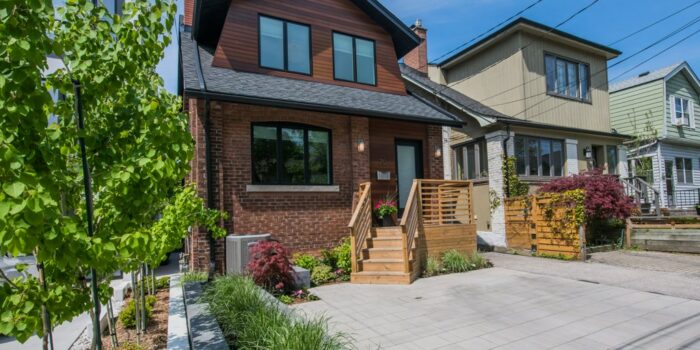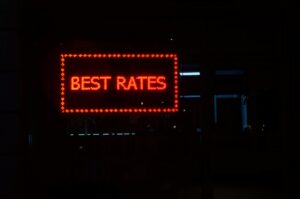Blog

Rent or Own By The Decades Part 2
Have you ever wondered if it has always been better to own or rent? We take a look at the decision to Buy vs rent at the start of each decade going back to 1980, outline some of the financial implications, and compare how things look today to decades past. Part 1 of this post showing 1980 and 1990 can be viewed here
2000s
| Rent | Own | |
|---|---|---|
| Monthly Costs (start of decade) |
$1,755 | $1,887 |
| Balance After 10 years (home app or GIC gains – payments) |
-$186,665 | -$19,645 |
| Premium to Own vs Rent in 2000 (mortgage cost with principal portion removed – rental cost) / rental costs) |
-12.9% | |
Clearly the pendulum swung too far, at the start of the new millennia purchasing looked like a no brainer. The premium you were paying to purchase vs rent was minimal, and when you factored in the principal you were paying down, it seemed downright advantageous to own. As rates dropped throughout the decade, owning was made even more affordable and appealing as your low risk investment alternatives failed to offer compelling returns.
Although rent increased by a moderate 27% over the decade, it was still an increase and was another advantage to owning. The overall cost outlay to own vs rent turned out to be similar throughout the decade. However, those who chose to purchase benefited from home price appreciation. Owners saw their leveraged asset increase 73% and came out almost $170,000 ahead of renters, reinforcing the idea that homes are likely to have good appreciation potential when rent and ownership costs are similar. When you factor in how much of your monthly ownership payments are going to pay down the principle, it’s tough to justify renting for a prolonged period in similar conditions.
2010‘s
| Rent | Own | |
|---|---|---|
| Monthly Costs (start of decade) |
$2,225 | $2,490 |
| Balance After 10 years (home app or GIC gains – payments) |
-$276,725 | -$351,775 |
| Premium to Own vs Rent in 2010 (mortgage cost with principal portion removed – rental cost) / rental costs) |
-22.16% | |
At times, owning a home in Toronto in the 2010s made you feel like you had access to your very own ATM. In peak appreciation years, Torontonians experienced numerous months where their home appreciation exceeded their income. Low rates made owning a home in the 2010s very affordable. While home prices increased, rates stayed low maintaining or distorting affordability throughout the decade. Rates were low to start the decade and essentially stayed that way. The challenge for those starting out became less about the monthly costs and more about the ability to come up with an adequate down-payment, when purchasing in one of Canada’s largest cities. Low rates limited the interest portion of mortgages and allowed home prices to outpace disposable income. The decade saw a strong demand for homes and the average home price increased by 135%. This overall increase was in spite of new regulations and taxes such as the stress test and Foreign Buyer Taxes, which was introduced and slowed demand by mid 2017.
While rates made owning extremely beneficial, rent steadily increased by 44% from 2010 to the end of 2019. As rents increased and rates stayed low, many renters ended up paying more to rent a home over this decade than it would cost to own. When you factor in home price appreciation and the amount owners were able to pay down in principle, the average owner likely netted out a whopping $600,000 ahead of the average renter.
2020‘s
| Rent | Own | |
|---|---|---|
| Monthly Costs (start of decade) |
$3,200 | $4,617 |
| Balance After 10 years (home app or GIC gains – payments) |
TBD | TBD |
| Premium to Own vs Rent in 2020 (mortgage cost with principal portion removed – rental cost) / rental costs) |
12.5% | |
The 2020s have presented one of the most volatile times for Toronto Real Estate in recent history. Just when demand seemed to reignite at the start of 2020, COVID brought new and unexpected challenges for Toronto’s housing market. Dramatic swings in demand and prices were felt on both the rental and ownership sides.
Home prices rose aggressively numerous times during this 4 year window and have also seen demand fall off a cliff on at least 3 points as the fallout from COVID or the reality of interest rate increases set in.
Rent prices dropped at the onset of COVID giving renters a rare reprieve and even discount on their rent, but rent quickly rebounded with double digit annual increases throughout most of 2022 and 2023. Despite COVID causing rent to drop for 18 months, overall they have increased 47% in just 4 years which exceeds rent increases experienced over most decades.
It seems everyone is paying more to house themselves today as the ultra low rates we experienced at the heart of COVID have since spiked at record speed. New cost realities are being passed on to both owners and renters. Despite home prices coming off their peak on multiple occasions in this 4 year window, owners have still managed to come out on top of renters as price appreciation has been high enough to offset increased financing costs. Those who chose to buy instead of rent in 2020 today are ahead by about $150,000.
The premium to own vs rent has also increased from 12.5% in 2020 to 15% today, trending in a direction that has made buying less appealing than how we started the past three decades.
-Key Takeaways:
- It’s not 1990: For those that think we are in for a 1990s style correction, this analysis indicates otherwise. While Buyers are willing to pay a premium to own, the premium to own vs rent is nowhere near what buyers were paying in 1990. However, the market is also not offering the opportunity that we started past decades with. In 1980, 2000 and 2010, the appeal to buy vs rent was stronger than it is today.
- Rental rates and ownership costs have both risen rapidly in recent years causing affordability constraints for both owners and renters; Indicating – much like food costs these days – we may need to expect to pay a higher portion of income towards shelter, whether we rent or own.
- When the opportunity to own at a discount vs. renting is available, Toronto home values have shown strong increases in the time period to follow.
- Future Rent: Anticipating what you may be forced to pay in future rent should be part of your financial planning.
Influences to Consider this year:
- Rates: Lower rates will make buying more appealing provided price increases don’t offset the equation. If you expect lower rates, Buying before they occur allows you to benefit from the home appreciation that might be caused by the lower rates. The inverse is also true.
- Immigration: Immigration will continue to put pressure on the demand for shelter, leading to higher rental prices and more competition amongst Buyers, provided we don’t find near term solutions to boost housing supply.
- Mortgage renewals: As more owners and investors renew into higher monthly costs more will choose to sell and this should help with resale supply.
- Affordability constraints: Household size can be adjusted to make shelter more affordable. Adding additional residents to your home or downsizing occurs when economic conditions impact affordability this can reduce rental and ownership demands.
Home Buyers today are showing a willingness to pay a premium to own instead of rent. What premium should you pay to own a home? The answer really depends on the Buyer. A family looking for stability and a home that could last over a decade should be willing to pay a higher premium to own, than a young single Buyer looking for a condo that they expect to sell within 5 years. It’s certainly interesting comparing what premium owners have been willing to pay and how that may have impacted their shelter costs and investments over the years.
Rent or Own By The Decades
There is a common piece of financial advice out there that your home is not an investment. While I understand the theory behind this advice, I ultimately disagree with this statement. Shelter is a necessity and an expense you can’t escape. What could be more important than investing in a place to provide shelter for both you and your family for decades to come? It’s true there are drawbacks to investing in a home purchase such as mobility and cash flow; however, owning a home provides you with a level of control that can’t be gained by investing in stocks, bonds, or riskier investments. Why not take an investment perspective with homeownership when it impacts your finances and living arrangement for the foreseeable future?
Understanding how rent increases over the years and how that might impact your retirement is sensible. Rent in the GTA seems to have increased an average of 40% every 10 years since 1980, an expense that can have a significant impact on your finances. It’s worth noting that although it’s been infrequent in Toronto, rent can also decrease. Most landlords and renters discovered this in 2020 and 2021 thanks to Covid. Financing a highly leveraged home purchase when homes may be overvalued can also be a bad recipe as you will see in our analysis below.
Given that our shelter options are rent, buy, or couch surf (my dog is a pro at this); we decided to do a generational dive and compare what it has been like to rent vs buy at the start of each decade. The reality is we all need shelter and should expect to pay something for it. The goal of this rent vs buy analysis is to help add some perspective. Understanding how this decision looked in the past may help you make better decisions going forward.
Metrics
For our comparison we used the average rent for a 3 bedroom apartment and the average home price. The three metrics we wanted to highlight were:
Monthly Costs: This is the estimated cost to rent at the start of the decade. The monthly cost to own includes your monthly mortgage payments, property taxes, and your monthly maintenance/replacement costs.
Premium to Own vs Rent ((Months cost to own less principal portion) – rental cost) / rental costs): This is a measure on how much the market is willing to pay to own in relation to renting. It’s a bit like a Price to Rent ratio, but is more robust as it factors in the impact interest rates have on owning and investing.
Balance at the end of the Decade: For renters it takes all the rent payments you would have made over the decade and reduces that amount by the potential investment gains you could have achieved by putting your down payment and purchasing costs along with your monthly cash flow savings from renting into a GIC.
For owners it shows how much equity you would have in your home after owning for 10 years with a 25 year amortization less what you would have spent on mortgage payments, home maintenance, property taxes, down payment and purchasing costs.
1980
| Rent | Own | |
|---|---|---|
| Monthly Costs (start of decade) |
$940 | $886 |
| Balance After 10 years returns (home app or GIC gains – payments) |
-$81,800 | $104,000 |
| Premium to Own vs Rent in 1980 (mortgage cost with principal portion removed – rental cost) / rental costs) |
-2.26% | |
In hindsight, purchasing a home in 1980 made sense. The extra monthly cost to buy vs rent in 1980 was minimal and when you remove the portion of your mortgage payment that was paying down principal you were actually paying a small premium to rent. Home prices skyrocketed from 1980-1989 rising a meteoric 285% leading a leveraged real estate investment to incredible returns. Those who chose to rent in 1980 saw rent increase 50% showing the double edged sword that renting can sometimes be. Most boomers will tell you that the 80s were not an easy decade to own as these homeowners were stretched to the limit with high interest. It wasn’t exactly the most inviting time to tie up money in an asset that wasn’t producing income or very liquid.
However, in the end, home buyers in 1980 came out ahead by about $180,000 as the decade wrapped up. Those that cashed out at the end of the 80s would have been the true winners as homeowners didn’t fare so well in the years ahead.
1990
| Rent | Own | |
|---|---|---|
| Monthly Costs (start of decade) |
$1,263 | $2,499 |
| Balance After 10 years (home app or GIC gains – payments) |
-$7,615 | -$313,615 |
| Premium to Own vs Rent in 1980 (mortgage cost with principal portion removed – rental cost) / rental costs) |
74% | |
The 1990s were a rare reckoning for home owners and those choosing to rent in the late 80s and early 90s were financially way better off. The premium home owners were paying for the privilege to own vs rent was over 70% of rent costs. The rapid value increase in the 1980s made carrying costs for owners look very unappealing by 1990. While rents increased from 1980-1990, it wasn’t enough to offset the home price increase.
Rates in the 90s also started the decade high and gave you a safe alternative investment option, helping to offset your shelter costs. Those who chose to rent vs own in the later 80s and early 90s would have benefited to the tune of hundreds of thousands of dollars,going far beyond offsetting the benefit of owning seen in the 1980s.
So the 80s was the decade to own, and the 90s was the decade to rent. What about the 2000s and how about today? My next post will show how today looks in comparison to decades past.
For Part 2 Showing 2000, 2010, 2020 and today Click Here
Limitations :
-This analysis has not included sales costs as it’s assuming those who chose to buy are still occupying the home. When selling homeowners would have an additional cost burden to factor in.
-It’s a snap shot comparison of purchasing at the start of the decade a purchase at mid or later in the decade would have a different result.
-The analysis focuses on rent vs buy dynamics and does not factor in influencers that might have influence such as affordability and income, immigration, supply levels etc.
-TREB Data is subject to jurisdictional changes which can distort data over longer period comparisons.
-Limited rental data for 1990 and lack of data for 1980 caused challenges to comparing and forced extrapolation and estimation and averaging between TREB data, CMHC, and CPI .
-The comparison of 3 bedroom apartment rental vs the average home price were deemed to be somewhat representative comparisons but would have a level of variance.
$250,000 Home Maintenance Bill
Trying to decide whether Buying or Selling is a good idea is extra challenging as market conditions continue to be very volatile. (For a quick take on current market conditions read: this post.) The reality is we need to live somewhere and for those of us that don’t have a rich uncle offering up a vacant home in the Annex, the choice is to Buy or Rent. Predicting how home prices will be impacted by interest rates, immigration, war, inflation etc., is certain to overwhelm. I find a buy vs rent analysis can be an effective anchoring tool in guiding your real estate decision in a head spinning time.
However, prior to looking at how Buyers have fared vs renters over the recent decades, I thought it was important to assess an often overlooked expense for Home Owners: Maintenance, Repairs and Renovations.
It’s not uncommon for an onlooker to see a home sell for hundreds of thousands of dollars more than it was purchased for in a few short years and think Real Estate offers easy returns. How many times have you heard someone say if only I had bought that Beach home in 2002 it was only $—–.
While it’s true Toronto Real Estate has offered great returns over the years, the gains don’t always come as easy as you would expect. Home owners and investors often put large amounts of time, effort and money into maintaining and renovating homes; sacrificing cash flow with the hopes of a future pay out. Often the capital investments put into a home can be forgotten when assessing the end result. When you sell your home for a hefty sum you probably aren’t thinking about the fence you spent $2,000 replacing 10 years ago.
Home owners should consider how much they will spend to keep their home in its current condition. This involves thinking about maintenance, repairs and even replacement costs over the life of a home. Condo buildings are required by law to conduct a reserve fund study to ensure an appropriate sum of funds are set aside for future expenses like elevator repair or replacement. A homeowner (both condo and freehold) would be wise to take the same approach to ensure they have accounted for any future expenses. Factoring in replacement costs in addition to repair/maintenance costs will help both investors and homeowners better understand the costs of home ownership. It can also help renters better evaluate their situation and determine whether renting or owning is right for them.
There are many different recommendations out there on how much to estimate for home maintenance and even replacement costs, but here are a couple common suggestions:
- The most common recommendation for home maintenance is to budget 1% of your home value, although often a range to 1-5% is cited. I find this to be an overestimation of your expected costs
- The square footage rule of $1 per square foot is another popular rule of thumb. While factoring in square footage is a good idea, this rule seems to underestimate what you should expect to spend.
The reality is that home maintenance and replacement cost is pretty personal for each home and homeowner. The age, size, quality of finishings along with a homeowner’s abilities, knowledge and taste will all have large impacts on how much you can expect to spend on annual maintenance and replacement.
The estimate I have come up with is $250,000
- This estimate is for an average quality, good condition, recently renovated, 1500 square foot detached home with 3 bedrooms, 2 bathrooms, and in the Toronto area.
- The estimate is for a 25 year period. This life span was used as it is the most frequent amortization period used for a mortgage on a property.
This estimate works out to $10,000/year or $833/month. Every year you should add inflationary costs to your annual budget of about 2-3% or whatever these costs are increasing by in your area. After all, 25 years from now that $250,000 is likely to cost you closer to $460,000 with 2.5% annual inflation.
Some items on my list included:
- Renovating bathrooms and kitchens and replacing light fixtures once over a 25 year period
- Putting aside money for the eventual repair/replacement of things like foundation, siding, electrical, and plumbing.
- It involves replacing appliances not once, or even twice, but 2.5 times over a 25 year period as most appliances these days don’t seem to last more than 10 years.
- It involves replacing a roof 1.25 times and furnace and A/C 1.5 times over this period.
For a more detailed list of what was included feel free to email me Andrew@relativerealty.com
This estimate is coming in below the 1%-3% of home value rule often found on the internet. But well above some of the often cited $1 per square foot estimate. Other factors that will influence this cost is your home type. A detached home is going to cost more than a townhome as you need to budget more for siding and foundation work and will likely have more landscaping costs.
While this is an expense that can vary greatly, these forgotten investments in your home should be factored into your Real Estate investment decisions. Having this line item in your overall budget will allow you to make a more realistic assessment when deciding to rent, own or invest in a property.
Up next:
Renting vs Buying in the 90s, 2000s, 2010s, and today.
Fall Market Conditions: Buyers Choice
In a typical year for Toronto Real Estate, the late fall months are considered a good time to purchase. Purchasing prior to the end of year has proven beneficial, as Sellers have historically commanded higher prices in the New Year. Inventory to start the New Year is traditionally lower and doesn’t meet the level of Buyers demand, meaning Sellers are able to get a premium over the previous year, even though only a few months have passed.
At this time last year, I felt less certain that the New Year would offer typical returns. Buyers’ affordability seemed limited given the unprecedented interest rate hikes we had just experienced. However, the market saw strong price appreciation beginning as early as February, with the average price increasing by double digits from fall to spring. It has since retracted those gains. Active listings in October have jumped to levels we haven’t seen in October since 2012, and the SNLR (Sales to New Listing Ratio) for October was 32% solidifying that we are in a Buyers market to wrap up 2023. The SNLR monthly measurement has only recorded 3 lower readings since 1996: Jan 2009, January 1996, and September 2023.
In less than 6 months, Months of inventory (MOI) has built to 4.2 a huge change from the low of 1.3 seen in May of this year. Buyers remain on the sidelines as Sales for 2023 are likely to come in below 2022 sales of 75,000, a low we hadn’t seen since 2008.
This leaves would-be Buyers to decide whether Buying prior to the year end will follow typical market patterns. It’s unknown whether Sellers will outpace Buyers to the market in 2023 and keep inventory levels high enough to maintain a buyers market and avoid a price run up typical of years past.
Rate Fever: Tiff As Popular as Swift
Torontonians seem to have become hyper aware of interest rates as well as who Tiff Macklem is and when the next rate announcement is coming from the Bank of Canada (BOC). We’re waiting for the next rate hike decision with the same anticipation of finding out whether we were lucky enough to be given a chance at a chance to buy a Taylor Swift ticket. While interest rate decisions are certainly impactful, this type of behaviour is likely to lead to an overreaction one way or the other.
Take this past spring for instance. The BOC’s decision not to raise rates in March and April combined with low inventory led to intense competition amongst active Buyers, causing month/month prices to increase from January to May. More recent ¼ point rate increases in both June and July caused many would-be buyers to pull out of the market, slamming the breaks on the GTAs real estate market for the second summer in a row.
Interest rate increases means affordability is driving more decision making. Unlike in Covid where Buyers didn’t think twice about spending for more home, today’s rates have forced everyone to give things a second thought. This limits the number of first time Buyers and prompts up-sizers to reconsider whether they need and can afford more space. In todays market both Buyers and Sellers seem to look to rate decisions for clarity on which way the market may go.
Investors have also become rate sensitive. No longer wiling to bet on strong year/year price appreciation. Questioning why they would buy and maintain a property, often at a monthly loss, for a renter who feels disgruntled about how much rent they pay. All at a time when alternative risk free investments offers yields not seen for decades.
The reality is inflation and rate directions remain unknown. Most economists we rely to help understand where rates may go, previously forecasted we would be in recession already, with rates headed down not up this fall. Other unknowns yet to play out include recent revelations on banks willingness to hold prolonged amortization for surprisingly large numbers of mortgage holders.
As we head towards a new rate announcement on September 6th, Real Estate watchers should take note of factors not just interest rates.
The cumulative impact of rate increases has been more than significant and rightfully caused a rethink on asset pricing; however, there are opposing forces to increasing rates that impact the Real Estate market: increasing labour costs to build new homes, record population growth, and supply constraints that all levels of government continue to bicker about. All at a time when future supply may be restrained as builders and investors look to reduce exposure to the industry and slow the release of new projects.
It’s true another ¼ point interest rate increase is likely to maintain negative momentum and further impact affordability. Keeping perspective that a ¼ point rate increase means $15 more a month for every $100,000 of financing could prove beneficial.
Months of inventory is trending to a more favorable direction for Buyers. Those looking for a home should take note. At this time last year I wrote a post on how Buyers markets should probably attract more Buyers. Purchasing in more favorable market conditions despite higher monthly mortgage costs can positively impact your bottom line to the tune of hundreds of thousands of dollars. If 2023 is anything like 2022, you will benefit by recognizing the advantages of Buying when conditions are more favourable for Buyers, not when interest rates decision lead to more Buyers in the market.
Rent or Buy 2023
Knowing whether to rent vs buy can always be a difficult decision. As my wife likes to remind me, sometimes both options are good options. While I advise you to consider the financial implications of renting vs buying, there are also non-financial considerations. The stability and forced savings of homeownership for some might be given more weight than the freedom and improved cash flow that renting offers to others. Other factors to consider as you look at the line comparison for buying vs renting include how current trends might have future impacts.
-If you think mortgage rates will go down, home prices are more likely to increase and lower financing costs will drive more Buyers to the market.
-Rents have been increasing and fast. Average rents have been increasing 10% or more year/year for the last few quarters and this seems unlikely to change given Canada’s population drive. Anybody renting something built after 2018 should anticipate large rental increases per year. I would recommend budgeting +10% annual rental increase for the next 2 years when making your decision.
-Sales and listing activity have remained below 5 and 10 year averages. This should mean pent up activity is building on both the sell and buy side.
-Those with job security and looking for stability in living arrangement should lean towards to owning.
-Those looking for more freedom and shorter turnover would be better suited to renting.
The Real Estate Narrative in 2023
Have you ever considered how what you read about a topic influences your opinion on something? After 10+ months of negative headlines it’s incredible how our opinion on Real Estate has changed since a year ago. Clearly it’s not just headlines that support this change in mindset. Unexpected levels of interest rate increases have made it necessary to re-evaluate debt levels and asset pricing. However, I do find it interesting how quickly our opinion of something can go in and out favor in a herd type mentality. Our need for housing didn’t change in March of 2022 when interest rates started their ascent. However, the demand fell off a cliff. Sales dropped 38% from 121,000 in 2021 to 75,000 in 2022. Buyers have retreated in masses despite a significant pull back in prices, as financing costs skyrocketed.
How often we read a negative or positive headline may have more influence than we realize on our decision making. This New Yorker article outlines how negative headlines can greatly influence your mindset. Our mindset can influence us to delay or stall making a large purchase. Inversely it can cause us to act out of impulsive or FOMO. Negative Real Estate headlines which we have been exposed to for the past 10 months or so, are certain to be weighing on a big decision like buying or selling a home. So when can we expect the headlines to change?
While there are many unknown influences which will shape the Real Estate narrative in 2023. Last years stats is one certainty we can look at to understand how the story might be told. The main data points reported on in mainstream media are frequently year over year price appreciation, and year over year sales. These numbers often become the headlines of our media and can greatly influence the public’s perception of how the market may be performing, even if the market’s performance transitioned months ago.
Average Prices: In January and February of 2022, prices showed strong appreciation with the average price topping out at $1,334,000 in the GTA before retreating between March – July down to $1,073,000. Prices remained fairly stable for the rest of the year, bouncing between $1,080,000 – $1,050,000 from August – December.
This means that year/year average price appreciation is almost certain to be quite negative for at least the first few months of 2023. Something you are probably seeing currently reported in the media to start the month of February.
Year/Year Sales: We also know that sales were fairly strong to start 2022, despite a lack of inventory. Sales numbers fell off in tandem with prices. Many months from May to December hit lows in sales numbers we haven’t seen for 20 + years. Therefore it’s more likely we see some positive news on sales numbers as we compare them to weaker months experienced in 2022.
Zoom Out: Given the reliance on monthly year/year reporting, it might surprise many to know that the average sale price in 2022 was actually a record year, and 8.6% higher than the average sale price achieved in 2021. However, this achievement was caused by the sales conducted in the early months of 2022, and not reflective of the current environment. It seems likely that we will have a lower average sale price in 2023 compared to 2022. While at the same time it seems likely to end the year with more positve momentum in sales and prices than we did in 2022.
Buyers seem to be in a stand off with Sellers as they wait for more inventory. Sellers have shown resistance to list their homes, which was key in stabilizing prices. Looking for a strategic window with favourable inventory will be key for both sides of the sale. A wave of inventory has potential to create more negative price headlines. Another year of low sales in 2023 is possible. However, 75,000 is not a realistic annual sales number for the GTA for a prolonged period of time. The lower the sales number is in 2023, the more offsetting I expect 2024 to be. Demand for home ownership is expected to build and sales to revert back to more normal levels above 90,000 sales.
If rental prices continue to soar, and interest rate increases cease, both investor and end users are likely to creep back into the market.. While the narrative is likely to remain quite negative to start the year. Last year’s low points create a more appealing comparison and are likely to help form more positive headlines as the year progresses. Buyers looking to purchase should give some consideration on how a narrative change could impact competition in the market.
Why Isn’t This Buyer’s Market Attracting More Buyers?
Rewind just 6 months ago and Buyers were climbing on top of each other to offer on any available home in the GTA, with the average price reaching $1,334,000 in February – a 27% increase from the year before. The market highly favored Sellers throughout 2021 and early into 2022 as Months of Inventory (MOI) was stuck at or below 1. Fast Forward to today and we are in a completely new world.
The average GTA home price in August was $1,074,000, down 1% year over year. You’d have to go back 20 years to find sales numbers equivalent to what we saw in summer 2022. Currently, the MOI is trending closer to 2.5, and the Sales to Listing Ratio has been hovering between 40-55% since March, typically 40% feels like a favourable Buyers market in Toronto.
So what’s the deal? Why don’t Buyers markets attract more Buyers? The reality is that Buyers markets don’t feel like you might expect them to. Buyers are often pumped full of anxiety and fears about future market conditions and further price pull backs. They enter negative feedback loops about job markets and economic uncertainties. Alternative risk free investments become appealing, and increased affordability constraints become a reality. They are also up against Sellers who are still coming off high sale expectations. Many of whom are often unwilling to sell for a dramatic reduction compared to their neighbour’s sale price earlier in the year
But the reality is that someone buying today will come out $200,000 better than someone who bought in February 2022, despite an increase in debt servicing costs. Granted, homes today are costing far more than they did pre-pandemic. The average home price in February 2020 was $910,000 and 5 year fixed rates were under 3%. Leaving both end users and investors reason to believe further price drops could be in store.
| November 2022 Potential | August 2022 | February 2022 | May 2022 | September 2021 | February 2020 | |
|---|---|---|---|---|---|---|
| Average Price | $1,020,300 | $1,074,000 | $1,334,000 | $1,212,000 | $1,135,000 | $910,000 |
| 20% Downpayment (DP) | $204,060 | $214,800 | $266,800 | $242,400 | $227,000 | $182,000 |
| Mortgage | $816,240 | $859,200 | $1,067,200 | $969,600 | $908,000 | $728,000 |
| 5 Year Fixed Rate % | 6.00 | 5.24 | 2.89 | 4.14 | 2.19 | 2.79 |
| Monthly Payment | $5,220 | $5,113 | $4,989 | $5,176 | $4,197 | $3,367 |
| 5 Years of Payments (5YP) | $313,249 | $306,839 | $299,370 | $310,577 | $251,818 | $202,036 |
| Interest Portion | $230,302 | $210,943 | $142,442 | $187,037 | $97,618 | $93,756 |
| Mortgage Balance End of Term | $733,052 | $763,104 | $910,072 | $846,460 | $815,801 | $619,721 |
| Land Transfer Tax | $33,750 | $35,910 | $46,310 | $41,430 | $38,350 | $29,350 |
| Invested (DP+LTT+ 5YP) | $551,059 | $557,549 | $612,480 | $594,407 | $517,168 | $413,386 |
| Invested + Mortgage Balance | $1,284,112 | $1,320,653 | $1,522,552 | $1,440,867 | $1,332,968 | $1,033,106 |
Investors seem to have more reason to take a pause given they are being offered stable investment options outside of real estate, like a GIC which can be easily purchased online with a few clicks.. The appeal of a guaranteed 4-5% return for doing nothing other than lending money is certain to keep many investors sidelined, at least until rates are no longer looking likely to rise and cap rates regain some sense of appeal.
What about end users though? With high Canadian immigration targets and rising rents, will would-be Buyers jump back in when the market is in their favor, or will they wait for lower rates to guide them back when competition for homes becomes fierce again?
Here are a few reasons why Buyers might not jump back in too quickly:
Monthly payments: Everything people buy lately seems to be driven by the monthly payment instead of outright purchase price. From cars to steak knives, consumers have the ability to purchase based on a monthly payment instead of the actual purchase price. A home purchase is certainly no exception. While the average GTA home price dropped 19.5% from February, the monthly mortgage payment required with 20% down has increased by about $120/month due to higher interest costs. Not to mention that today’s Buyer can expect to pay 52% higher monthly payments for the average house than they had to pre-pandemic in early 2020.
Stress Test: The stress test is limiting borrowers capacity. Until recent months, borrowers would have been stress tested at the 5.25% minimum rate (qualifying rate +2%) that banks used for stress testing. Buyers looking to take a 5 year fixed rate these days are being stress tested at 6.5%-7.25% range. Those opting for a 5 year variable are in the 5.5-6.5% range. Every rate increase these days is limiting borrowers capacity and directly impacting their maximum purchase price. Buyers borrowing from September 2021 to February 2022 saw an increase in fixed interest rates, but their capacity to borrow was not impacted as they were still being stress tested at the minimum rate, maintaining an environment for price appreciation.
Demand was pulled forward: While investors have stopped Buying, and some Buyers have been sidelined by affordability constraints, another reason for less demand could be because some of today’s Buyers already bought. Meaning the high sales volume of 2021 ate into 2022 sales. However, if 2022 (and 2023) sales go too low, we could quickly have the reverse effect again provided the ability to purchase is there.
With rates continuing to increase, it’s possible and even likely we could see further price pull backs. Increasing interest rates is directly impacting how much Buyers can borrow and spend. It’s important to keep in mind that this will impact various areas and home types differently.
Home prices are being put to the ultimate test with rates increasing faster than they have for multiple decades. While we have been given many reasons to think our home is worth more today than it was before Covid, capacity to purchase can’t be underestimated. It’s important to consider how much interest rates will continue to impact today’s Buyer. After all, 2020 prices ($910,000) at a 6% interest rate instead of 2.79% takes your mortgage payment from $3,367 to $4,657, an increase of 38% in just 2.5 years. Something nobody was expecting at that time.
Sold: Beach Detached with attention paid to every detail.

A slow summer led to a month long negotiation for this 3 Bedroom, 2 Bathroom detached home with inviting backyard at 70 Courcelette. The Buyers were eventually left Buyers with nothing to do but move in and enjoy as every detail was taken care of with this renovated home.
Does Toronto Real Estate Make Investment Sense Right Now?
Covid and ultra low interest rates seemed to throw investment rules on their head while creating excessive growth and volatility in areas such as tech stocks, crypto currencies, and yes Canadian Real Estate. While crypto and tech stocks have pared a good portion of gains in recent months, the average sale price for a GTA home was up 32% year/year from Feb 2021 to Feb 2022. Expectantly, Canadian Real Estate’s appreciation is going to be stickier and more stable than other investments, but the average price has pulled back since its February highs. The average price in the GTA is down 6% from February to April and year/year sales are down over 30% and 41% in March and April.
What changed?
Yes. Interest rates increased. The Bank of Canada finally decided it could no longer ignore the fact that inflation is coming in well above its target and has stopped their bond buying program, and increased the benchmark interest rate by 0.75% to 1% with an additional 1.5% increase still expected over the next 18 months or so.
What also happened is that cap rates for GTA real estate hit extreme lows. As prices skyrocketed the past 18 months, rents have just recently recovered near pre-pandemic levels.
What this means is that investors can put their money in a 3-5 year GIC and make 4%/year, or buy a Toronto condo and make less than 2% based on February’s Rent vs Buy Analysis.
In recent years, GTA real estate investors have been willing to overlook low cap rates in exchange for high price appreciation, and they have benefited greatly from doing so. However as cap rates bottom out and interest rates increase, should they continue to do so? Take a look at the following cap rates from February’s analysis.
Leslieville Condo 1.8%
Danforth Detached 1.85%
Scarborough Bungalow with Basement Apartment 2.98%
To get February cap rates to match current GIC returns rents would need to increase 30-70% or prices would have to drop by over 30%-75%, or some combination of the two.
| February Cap Rate | Rent Increase to get to 4% Cap | Price Drop to get to 4% Cap | |
| Leslieville Condo | 1.8% | 51% | 54% |
| Danforth Detached | 1.85% | 75% | 42% |
| Scarborough Bungalow w/ Basement Apt | 2.77% | 29% | 31% |
What’s to expect because of this:
Higher Rents: We are already seeing rents trend higher and I believe this will continue as rental demand in Toronto experiences increased pressure from high immigration targets. One and Two bedrooms apartment rents rose over 17% from a much less competitive Q1 2021. As mortgage rates increase, more would be Buyers will also turn to the rental market putting further pressure on rent.
Less Investors: With investors making up close to 25% of Buyers in recent years don’t be surprised to see this number drop. Investors finally have some incentive to lend their money instead of invest, and many will choose that risk free route or seek markets with better cap rates. Much like stock market investors, we can expect investors to have more cash flow discipline as the cost to borrow increases. While end users may also pull back on their Buying plans, this is more likely to be shorter term and demand should remain if employment and wages remain strong and rents increase.
Lower Prices: A higher MOI leads to more balanced conditions and downward pressure on prices. A 1.6 MOI is still very much in the Sellers favour, and Sellers are less likely to list if they don’t expect to get their desired price. However, if supply increases and negative demand pressures continue we should see prices correct more than the 6% seen so far.
Affordability Constraints: The government has introduced programs that will ease some affordability constraints such as first time home buyer TFSA or the non housing policy likely to have the biggest stimulus impact on housing being affordable daycare. However, rising prices have made it increasingly difficult for first time buyers to come up with a down payment and rising rates will reduce purchasing power and may cause buyers to look at more affordable options.
It’s not all negative. Canada is a safe and desirable place to live. If the government executes on the high immigration targets, strong demand for housing will continue. Unemployment rates and wage growth have been very positive. And while everyone is expecting rates to rise in the short term, many expect them to have to reverse course shortly after.
While investors are taking a beat or two, end user Buyers should keep an eye for good opportunities, while the market is less competitive. If rents increase as expected more Buyers will eventually be drawn back into the market in due time. Don’t purchase if forecasted interest rates are not manageable. While nobody knows how inflationary pressures will play out, there will be a breaking point for how high the BOC can push interest rates. Given how much more indebted Canadians are then in the past, small interest rate hikes will have much larger impacts than they did in the past.







